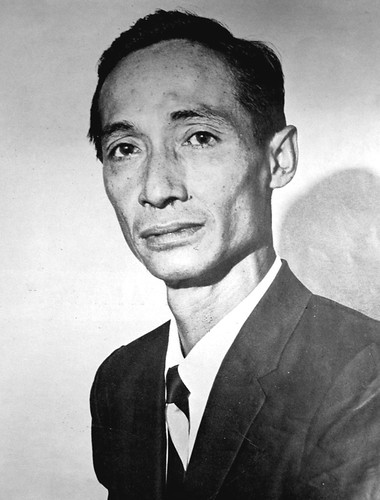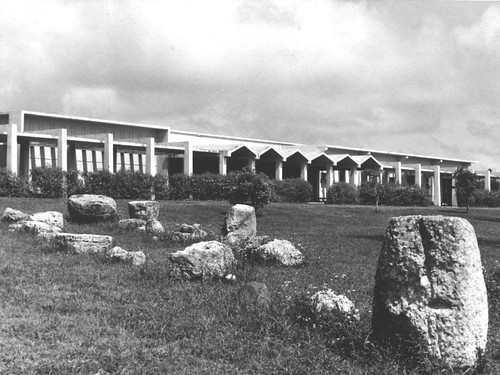Micronesian Area Research Center (MARC)
World-class Micronesia research facility
For more than fifty years, scholars, researchers, journalists, and students intent on finding out more about the peoples and cultures of the western Pacific have visited the Richard F. Taitano Micronesian Area Research Center (commonly referred to as MARC) at the University of Guam in Mangilao.
Following humbled beginnings and decades of development, the center today is considered by many to be a world-class facility for social sciences and humanities research about Guam and Micronesia, and to an extent, other Pacific islands.
Humble beginnings
Between March and July 1967, Dr. Antonio C. Yamashita, president of the then-College of Guam, gathered noted scholars of Guam including Paul Carano, co-author of A Complete History of Guam, professor of Guam History at the college, and the eventual center’s first director; Dr. Lucius Eldredge of the UOG Marine Lab; Emilie G. Johnston, college student; and Marjorie Driver, principal of St. John’s School—to discuss the need to establish a research library in and about Micronesia. According to Driver:
Shortly after the end of World War II, an influx of scholars representing various disciplines and the long-range interests of the United States arrived in Micronesia. Island people were subjected to interviews, studies, analyses, etc., yet the data, observations, generalizations, and conclusions were unavailable to them, as were the scholars’ library resources.
Guam’s leaders were concerned because they realized that the knowledge derived from the scholars’ research was of vital importance to the islanders, yet it was restricted and generally unavailable to them, as if it were of no concern to them. Moreover, the resource libraries rich in materials on Micronesia were located at distant institutions, generally inaccessible to the island people.
With a transfer of $10,000 from the Chamorro Language Commission, Governor Manuel F. Guerrero began the process to create MARC. Public Law 9-106, written by Guam Congressman Richard Flores Taitano—at the center’s thirtieth anniversary in 1997, it was renamed in honor of Congressman Taitano—formally created MARC as “a separate and distinct program of the College.” Though considered a research center, its start was anything but auspicious. Located in a room of the now demolished Building B at the University of Guam, the three researchers set up shop to begin molding MARC after that of the Bernice P. Bishop Museum in Honolulu, Hawaii.
A year later, MARC moved to the university’s RFK Memorial Library and expanded its faculty—and its general collection of published materials—to include Felicia Plaza, MMB; Thomas B. McGrath, SJ: and, Rosita Duenas. Additional faculty and staff were added several years later, including Spanish historian Teresa del Valle and librarian Albert L. Williams. Johnston became in charge of developing the growing photo collection. Given the Spanish bent of the centers’ researchers, it is no wonder that MARC focused its primary development on translating and publishing Spanish documents.
Between 1979 and 1995, MARC concentrated on developing its research. Complementing Dr. Dirk Ballendorf’s prodigious research and writing was noted Micronesian archaeologist Dr. Hiro Kurashina and numerous American, European, and Asian linguists who translated French, German, and Japanese materials.
MARC collections
In 1992, the research center moved from the Health Sciences Building to its modern two-story facility behind the College of Liberal Arts and Social Sciences building. The center housed the Guam and Micronesia Reference Collection, Photograph Collection, Map Collection, and the Spanish Documents and Manuscripts Collections. It also provided a variety of research-related services to the university and general communities, including electronic databases, Chamorro genealogies, the popular MARC Seminar Series, and its publications program.
As the University of Guam expands its purview in the western Pacific, administrators have reorganized its research centers into Centers of Excellence. MARC, as a center of excellence, now includes the Micronesian Language Institute and the Chamorro Language and Culture Center.
Guam and Micronesia Reference Collection
The collection is one of the world’s largest and most extensive repositories of Guam and Micronesia resource materials, with holdings totaling more than 40,000 volumes (Storie, 2008). Also included in the collection are 800 unpublished theses and dissertations. In addition to academic-related materials, MARC has a complete collection of the following daily, weekly or monthly publications: Guam News Letter, Guam Recorder (first and second series); Guam Times Weekly, Pacific Daily News, Pacific Profiles; and a fair number of Guam Tribune, Marianas Variety News and Views and Guam Variety News and Views, Saipan Tribune, Tia Belau, FSM News, and Island Times newspapers. According to MARC Librarian Monique Storie the publications with be placed on-line in the near future.
The collection is non-circulating (materials cannot be checked out) and closed-stack (technicians must locate and retrieve materials on behalf of the patron), and is one of the few areas at the university that affords a quiet reading room and private cubicles. It’s open Monday through Thursday, 9 am – 5 pm. MARC’s catalogue can also be accessed on-line.
Spanish Documents Collection
The extensive documents—more than 100,000 pages of manuscripts and other printed materials—contained in the Spanish Documents Collection mirror Spain’s presence in the Mariana Islands from 1521 to 1898. Spanish documents from such historical periods as Spain’s Pacific explorations, galleon trade, and the colonial administration in the Mariana and Caroline Islands are available to researchers. Holdings include materials from the General Archives of the Indies (Seville, Spain), the Philippines National Archives (Manila), the General Archives of Mexico, the Royal Academy of History (Madrid), and the Jesuit archives in Rome and Spain.
Photograph Collection
Contained within the photograph collection are more than 23,000 prints, 90,000 negatives, and 4,000 slides with printed guides to the Guam Series, the Governor (Willis) Bradley collection, and the American Era Historic Sites from the U.S. National Archives. According to Storie, MARC acquired several hundred historical images of the German Period in Micronesia (1899-1914) from the relatives of Georg Fritz, the German Administrator in the then-German controlled Northern Mariana Islands. Recently, U.S. World War II veteran, Ernie Vigdor, donated pictures of immediate post-war Guam (1945-1946) during the golden anniversary of the recapture of Guam by U.S. armed forces in July 1994.
Electronic Databases
In 1982, through a grant from the U.S. Department of Agriculture in cooperation with the College of Agriculture and Life Sciences, a bibliographic database was created and is housed at the Guam and Micronesia Reference Collection. Published and unpublished sources concerning tropical agriculture, aquaculture, mariculture, forestry, community development, and other natural sciences in Micronesia are available in electronic form.
Chamorro Genealogies
As of 2008, more than 100 Chamorro families’ genealogies have been traced as part of the Chamorro Roots Project. Librarian Albert Williams’ family files, painstakingly detailed and dating to 1987, have been combined with civil and church records on births, baptisms, marriages, and deaths that have been cross referenced with voter registries, extensive interviews, and archival data, including the 1897 Census of the Mariana Islands and the 1920 Church Census of Guam.
Map Collection
The Map Collection contains about 1,000 rare sixteenth and seventeenth historical and contemporary United States Geological Survey and Defense Mapping Agency Hydrographic & Topographic Center maps, as well as a large number of Spanish, German, and Japanese language maps.
Manuscripts Collection
Much of the post-war change recorded for posterity pertains to Guam’s political and social leaders—Agueda Iglesias Johnston, Congressman Antonio B. Won Pat, and Governor Ricardo J. and First Lady Madeleine Z. Bordallo to name but a few. Currently, Congressman Robert A. Underwood’s papers are being catalogued. Their papers are housed in the growing Manuscripts Collection, a collection that contains more than two million pages of documents, including letters, diaries, photographs, and other papers. In addition to these original papers, MARC has copies of archival collections from other institutions, such as the U.S. National Archives and the Library of Congress.
Publications
Since its inception in 1979, the MARC publications program has published more than 250 scholarly titles by scholars from diverse backgrounds and disciplines. MARC publications have been distributed throughout the insular Pacific and beyond to universities, libraries, and bookstores. Some of MARC’s well-known titles include:
- 1985 & 2004 – García, Francisco. The Life and Martyrdom of Diego Luis de San Vitores, S.J. Translated by Margaret M. Higgins, Felicia Plaza, and Juan M.H. Ledesma. Edited by James A. McDonough. MARC Monograph Series 3.
- 1987 & 1992 – Souder-Jaffery, Laura Marie Torres. Daughters of the Island: Contemporary Women Organizers of Guam. MARC Monograph Series 1.
- 1989 – Driver, Marjorie G, ed. Fray Juan Pobre de Zamora and His Account of the Mariana Islands, 1602.
- 1993 – Brunal-Perry, Omaira. A Question of Sovereignty: What Legitimate Right did Spain have to Its Territorial Expansion? MARC Educational Series 15.
MARC has established a distribution agreement with University of Hawaii Press to distribute MARC publications.
For further reading
Guampedia Staff. “MARC Publications.” In Guampedia.com, last modified 30 March 2022.
University of Guam. “Micronesian Area Research Center.“





